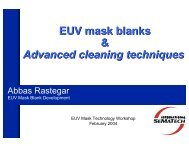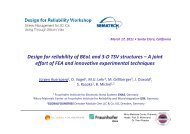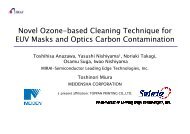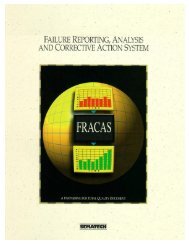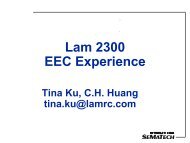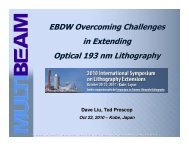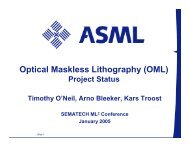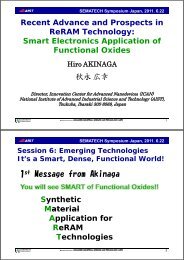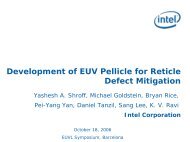Investigation of PVD TiN Process for 28nm Hi-K PMOS ... - Sematech
Investigation of PVD TiN Process for 28nm Hi-K PMOS ... - Sematech
Investigation of PVD TiN Process for 28nm Hi-K PMOS ... - Sematech
You also want an ePaper? Increase the reach of your titles
YUMPU automatically turns print PDFs into web optimized ePapers that Google loves.
<strong>Investigation</strong> <strong>of</strong> <strong>PVD</strong> <strong>TiN</strong> <strong>Process</strong> <strong>for</strong><br />
<strong>28nm</strong> <strong>Hi</strong>-K K <strong>PMOS</strong> Effective Work<br />
Function Enhancement<br />
UMC/ ATD_AM/ Adv.TF Department<br />
Kun-Hsien<br />
Lin, Chi-Mao Hsu, Hsin-Fu Huang, Tzung-Ying<br />
Lee, Min-Chuan Tsai, J. F Lin, Chan-Lon Yang, J.Y. Wu<br />
2010 AMC, Oct. 7, 2010
HK MG CMOS Flow<br />
Advanced Metallization Conference - 2010<br />
STI<br />
Well Imp<br />
Gate dielectric<br />
Gate Patterning<br />
Spacer 1<br />
LDD imp<br />
SiGe<br />
Spacer 2<br />
S/D imp /Anneal<br />
NiSi<br />
Dummy ILD<br />
Replacement Gate<br />
Contact<br />
BEoL<br />
P. 2
Replacement Gate Loop<br />
SiN CMP<br />
Anneal scheme split<br />
Advanced Metallization Conference - 2010<br />
Dummy Poly Strip<br />
Sel. Etch Stop Barrier Dep.<br />
(TaN)<br />
<strong>PMOS</strong> WF Metal Dep.<br />
(<strong>TiN</strong>)<br />
NMOS LT<br />
Oxygen Anneal<br />
Oxygen Anneal<br />
Oxygen Anneal<br />
WF Metal Etch on NMOS<br />
NMOS WF Metal + Al<br />
Al CMP<br />
P. 3
Experiment Apparatus<br />
Advanced Metallization Conference - 2010<br />
RF power<br />
supply<br />
DC power<br />
supply<br />
Wafer Bias on Capacitance<br />
tuning position ( ACT% )<br />
CT Curve<br />
200<br />
150<br />
100<br />
50<br />
Voltage (V)<br />
0<br />
0<br />
-50<br />
10 20 30 40 50 60 70 80 90 100<br />
-100<br />
-150<br />
Capacitance<br />
tuning box<br />
-200<br />
-250<br />
ACT Setting (%)<br />
Center Tap Bias<br />
üUtilize the capacitance tuning underneath wafer to<br />
build up various wafer bias, <strong>for</strong> film stress modulation.<br />
P. 4
Advanced Metallization Conference - 2010<br />
<strong>PVD</strong> Wafer Bias and <strong>TiN</strong> Film Stress<br />
CT Curve<br />
200<br />
150<br />
100<br />
Wafer Bias<br />
Voltage (V)<br />
50<br />
0<br />
-50<br />
-100<br />
0 10 20 30 40 50 60 70 80 90 100<br />
-150<br />
-200<br />
Center Tap Bias<br />
-250<br />
A B C<br />
ACT Setting (%)<br />
-0.14 GPa<br />
Film Stress<br />
-1.7 GPa<br />
-4.1GPa<br />
üControl <strong>PVD</strong> wafer bias to modulate the <strong>TiN</strong> film stress.<br />
P. 5
Advanced Metallization Conference - 2010<br />
XPS Composition <strong>of</strong> <strong>TiN</strong> Stress Split<br />
counts/sec<br />
3000<br />
2500<br />
2000<br />
1500<br />
1000<br />
500<br />
0<br />
390 395 400 405 410 415<br />
binding energy (eV)<br />
N<br />
N-1s@4/1_0.14GPa<br />
<strong>TiN</strong>-A<br />
<strong>TiN</strong>-B<br />
N-1s@4/1_1.7GPa<br />
N-1s@4/1_4.2GPa<br />
<strong>TiN</strong>-C<br />
counts/sec<br />
5000<br />
4000<br />
3000<br />
2000<br />
1000<br />
0<br />
440 450 460 470 480<br />
binding energy(eV)<br />
Ti<br />
Ti-2p@4/1_0.14GPa<br />
<strong>TiN</strong>-A<br />
<strong>TiN</strong>-B<br />
Ti-2p@4/1_1.7GPa<br />
Ti-2p@4/1_4.1GPa<br />
<strong>TiN</strong>-C<br />
count/sec<br />
4000<br />
3500<br />
3000<br />
2500<br />
2000<br />
1500<br />
1000<br />
500<br />
0<br />
520 530 540 550<br />
binding energy (eV)<br />
O<br />
O-1s@4/1_0.14GPa<br />
O-1s@4/1_1.7GPa<br />
<strong>TiN</strong>-A<br />
<strong>TiN</strong>-B<br />
O-1s@4/1_4.1GPa<br />
<strong>TiN</strong>-C<br />
(L)<br />
(M)<br />
(H)<br />
counts/sec<br />
300<br />
250<br />
200<br />
150<br />
100<br />
50<br />
0<br />
90 95 100 105 110 115<br />
binding energy (eV)<br />
Si<br />
Si-2p@4/1_0.17GPa<br />
Si-2p@4/1_1.7GPa<br />
<strong>TiN</strong>-A<br />
<strong>TiN</strong>-B<br />
Si-2p@4/1_4.1GPa<br />
<strong>TiN</strong>-C<br />
ü<strong>TiN</strong>-C (<strong>Hi</strong>-stress) is with lower oxygen content, but N, Ti<br />
species are the same <strong>for</strong> various stress <strong>of</strong> <strong>TiN</strong>.<br />
P. 6
<strong>TiN</strong> Film Property on eWF Boost<br />
Advanced Metallization Conference - 2010<br />
1.2<br />
KSC4A - 12 Area 29 Sites per Area, <strong>PMOS</strong><br />
1<br />
Flat Band Voltage, Vfb [V]<br />
0.8<br />
0.6<br />
0.4<br />
0.2<br />
<strong>TiN</strong>-A<br />
Low stress 0.14GPa<br />
<strong>TiN</strong>-C<br />
<strong>Hi</strong>gh stress 4.2GPa<br />
60 mV<br />
0<br />
0 0.5 1 1.5 2 2.5 3<br />
EOT [nm]<br />
ü<strong>Hi</strong>gh compressive stress <strong>TiN</strong> boost <strong>PMOS</strong> eWF by 60mV.<br />
P. 7
Advanced Metallization Conference - 2010<br />
XPS Oxygen Depth Pr<strong>of</strong>iling _ <strong>TiN</strong><br />
<strong>TiN</strong>-A<br />
(Low-Stress)<br />
<strong>TiN</strong>-C<br />
(<strong>Hi</strong>gh-Stress)<br />
Surface<br />
N<br />
Surface<br />
N<br />
Ti<br />
Ti<br />
O<br />
O<br />
üBoth <strong>TiN</strong>-A&C show the oxygen concentration is higher<br />
in the film surface.<br />
üIt suggests the oxygen is from the contamination <strong>of</strong> air<br />
exposure.<br />
P. 8
Advanced Metallization Conference - 2010<br />
<strong>TiN</strong> _ Oxygen % v.s. Film Stress<br />
ü <strong>TiN</strong> O% track the inverse trend <strong>of</strong> film stress.<br />
ü Since the oxygen is proved from air exposure, the<br />
higher O% <strong>of</strong> <strong>TiN</strong> is with higher oxygen affinity.<br />
P. 9
<strong>TiN</strong> _ Vfb on Film Stress<br />
Advanced Metallization Conference - 2010<br />
<strong>TiN</strong>-C<br />
<strong>Hi</strong>gh stress<br />
Middle stress<br />
<strong>TiN</strong>-A<br />
Low stress<br />
üLow-stress with higher oxygen affinity, which get more<br />
oxygen from hi-k layer, and generate more oxygen<br />
vacancy and the Vfb is lower.<br />
P. 10
Advanced Metallization Conference - 2010<br />
Mechanism <strong>for</strong> <strong>PMOS</strong> EWF Boost by<br />
Oxygen Anneal<br />
Oxygen Anneal<br />
( ref. : SEMATECH PAG meeting Y2009)<br />
üBenchmark showed oxygen vacancy passivation ( by<br />
oxygen anneal) could boost Vfb <strong>of</strong> <strong>PMOS</strong>.<br />
P. 11
Advanced Metallization Conference - 2010<br />
Oxygen Anneal <strong>for</strong> eWF Boost (<strong>PMOS</strong>)<br />
Flat Band Voltage, Vfb [V]<br />
1<br />
0.9<br />
0.8<br />
0.7<br />
0.6<br />
0.5<br />
0.4<br />
0.3<br />
0.2<br />
0.1<br />
0<br />
1<br />
2<br />
3<br />
KSC0T - 6 Area 29 Sites per Area, <strong>PMOS</strong><br />
<strong>TiN</strong>100A/ O2 100% PMA/ TaN10A/ <strong>TiN</strong>(0/60) 20A/ HfOx<br />
Oxy Anneal after TaN<br />
O2 100% PMA /<strong>TiN</strong>100A/ TaN10A/ <strong>TiN</strong>(0/60) 20A/ HfOx<br />
Oxy Anneal after <strong>TiN</strong><br />
<strong>TiN</strong>100A/TaN10A/O2 100% PMA/<strong>TiN</strong>(0/60) 20A/HfOx<br />
Oxy Anneal after Poly Strip<br />
<strong>TiN</strong>100A/TaN10A/<strong>TiN</strong>(0/60) 20A/HfOx<br />
No Anneal (Control)<br />
0 0.5 1 1.5 2 2.5 3<br />
EOT [nm]<br />
üO2 anneal after dummy poly strip ( split #1 ), which can<br />
improve eWF by 230 mV.<br />
2<br />
3<br />
1<br />
P. 12
Summary :<br />
Advanced Metallization Conference - 2010<br />
1. Utilize <strong>PVD</strong> <strong>Process</strong> factors to control wafer bias and obtain<br />
different film stress level <strong>of</strong> <strong>TiN</strong>. Oxygen content track the<br />
inverse trend <strong>of</strong> stress level.<br />
2. Depth pr<strong>of</strong>iling confirm the oxygen content <strong>of</strong> <strong>TiN</strong> is from the<br />
oxygen contamination when air exposure.<br />
3. Oxygen content <strong>of</strong> <strong>TiN</strong> track the inverse trend <strong>of</strong> film stress,<br />
hence, the film stress can be an indicator <strong>of</strong> oxygen affinity.<br />
4. <strong>TiN</strong> <strong>of</strong> high oxygen affinity will getter more oxygen and generate<br />
more Vo ( oxygen vacancy), Vfb become lower.<br />
5. Optimized Oxygen anneal scheme can efficiently passivate Vo<br />
in HK layer and boost the eWF <strong>of</strong> <strong>PMOS</strong>.<br />
P. 13
Advanced Metallization Conference - 2010<br />
Thank You!<br />
P. 14



